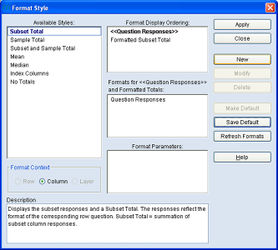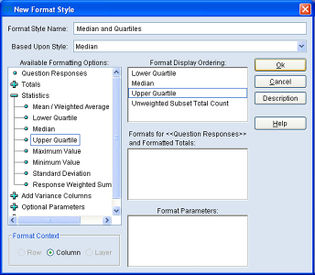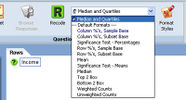Difference between revisions of "Quartile formats"
| Line 1: | Line 1: | ||
| − | mTAB has always allowed users to ask for descriptive statistical measures such as the Mean, Median and Standard Deviation. The Mean allows users to obtain an average value, where all responses are summed and then divided by the number of respondents. The Standard Deviation is a measure | + | mTAB has always allowed users to ask for descriptive statistical measures such as the Mean, Median and Standard Deviation. The Mean allows users to obtain an average value, where all responses are summed and then divided by the number of respondents. The Standard Deviation is a measure that gives an understanding of how widely spread data is around the mean value and the Median tells us the Mid-Point of a data range (i.e. if all the responses to a question were put in numerical order, what would be the middle value). |
| − | The Median is a particularly good measure to use when looking at numerical questions where there are no real upper and lower limits, | + | The Median is a particularly good measure to use when looking at numerical questions where there are no real upper and lower limits, such as an Income question. As the Median only takes the mid-point, it cannot be influenced by outliers in your dataset. For example if you have a few respondents with abnormally high or low income values, your Mean value could be pushed artificially high or low. |
| − | To enhance your understanding of the spread of data in a question such as Income, it is now possible to calculate the Upper and Lower Quartiles As the Median is the mid-point, we can agree that it is highlighting where 50% of all respondents fall above and 50% fall below a particular point | + | To enhance your understanding of the spread of data in a question such as Income, it is now possible to calculate the Upper and Lower Quartiles. As the Median is the mid-point, we can agree that it is highlighting where 50% of all respondents fall above and 50% fall below a particular point. To extend the Median, the Upper Quartile shows you the point where 25% are above and 75% of respondents are below and therefore the Lower Quartile shows you the point where 75% are above and 25% of respondents are below. |
| Line 23: | Line 23: | ||
| − | We now need to add the Quartiles to this format. We can do this by clicking on the blue + next to Statistics and this category will expand. | + | We now need to add the Quartiles to this format. We can do this by clicking on the blue [+] next to Statistics and this category will expand. |
Now simply double click Lower Quartile and Upper Quartile and they will be added to the top box on the right hand side of the screen. | Now simply double click Lower Quartile and Upper Quartile and they will be added to the top box on the right hand side of the screen. | ||
| − | To tidy up how the data will be displayed in the spreadsheet when using this format, drag the Lower Quartile and Upper Quartile around until they fall either side of the Median value. | + | |
| + | To tidy up how the data will be displayed in the spreadsheet when using this format, drag the Lower Quartile and Upper Quartile around in the Format Display Ordering section until they fall either side of the Median value. | ||
| Line 34: | Line 35: | ||
| − | Press the OK button. | + | Press the OK button. In the dialog that follows, select if you want the new format to be Private or available to All Users. If this dialog does not appear, the format will automatically be saved as Private. The format will be added to the question selection view toolbar listing of available formats. |
| Line 44: | Line 45: | ||
When the new format is now selected on a question such as Income, results similar to those displayed below will appear in the spreadsheet. | When the new format is now selected on a question such as Income, results similar to those displayed below will appear in the spreadsheet. | ||
| + | |||
| + | |||
[[File:Formats quartile-formats spreadsheet-view.jpg|thumb|center|x350px]] | [[File:Formats quartile-formats spreadsheet-view.jpg|thumb|center|x350px]] | ||
| − | Note: you can repeat the above process to add the Quartiles as a Column format, simply ensure you have the column window on the right hand side of mTAB before choosing the Format styles option. | + | '''Note:''' you can repeat the above process to add the Quartiles as a Column format, simply ensure you have the column window on the right hand side of mTAB before choosing the Format styles option. |
Revision as of 12:11, 29 July 2013
mTAB has always allowed users to ask for descriptive statistical measures such as the Mean, Median and Standard Deviation. The Mean allows users to obtain an average value, where all responses are summed and then divided by the number of respondents. The Standard Deviation is a measure that gives an understanding of how widely spread data is around the mean value and the Median tells us the Mid-Point of a data range (i.e. if all the responses to a question were put in numerical order, what would be the middle value).
The Median is a particularly good measure to use when looking at numerical questions where there are no real upper and lower limits, such as an Income question. As the Median only takes the mid-point, it cannot be influenced by outliers in your dataset. For example if you have a few respondents with abnormally high or low income values, your Mean value could be pushed artificially high or low.
To enhance your understanding of the spread of data in a question such as Income, it is now possible to calculate the Upper and Lower Quartiles. As the Median is the mid-point, we can agree that it is highlighting where 50% of all respondents fall above and 50% fall below a particular point. To extend the Median, the Upper Quartile shows you the point where 25% are above and 75% of respondents are below and therefore the Lower Quartile shows you the point where 75% are above and 25% of respondents are below.
Creating the New Format
To obtain the Quartiles in mTAB, we need to create a new format using the Format Style Editor.
To create a new format, select the Format Style icon to the right of Available Format Styles or, alternatively, right click your mouse in a rows/columns/layer panel and select Format Styles.
The next step is to choose a format style which can be used as the basis of the new format. Median seems to be a logical choice in this example.
We now need to add the Quartiles to this format. We can do this by clicking on the blue [+] next to Statistics and this category will expand.
Now simply double click Lower Quartile and Upper Quartile and they will be added to the top box on the right hand side of the screen.
To tidy up how the data will be displayed in the spreadsheet when using this format, drag the Lower Quartile and Upper Quartile around in the Format Display Ordering section until they fall either side of the Median value.
Now give the format style a name, such as "Median and Quartiles" as shown.
Press the OK button. In the dialog that follows, select if you want the new format to be Private or available to All Users. If this dialog does not appear, the format will automatically be saved as Private. The format will be added to the question selection view toolbar listing of available formats.
Selecting the New Format
With the column banner questions highlighted, pull down the Available Format Styles toolbar menu as shown below and select our newly created format.
When the new format is now selected on a question such as Income, results similar to those displayed below will appear in the spreadsheet.
Note: you can repeat the above process to add the Quartiles as a Column format, simply ensure you have the column window on the right hand side of mTAB before choosing the Format styles option.


